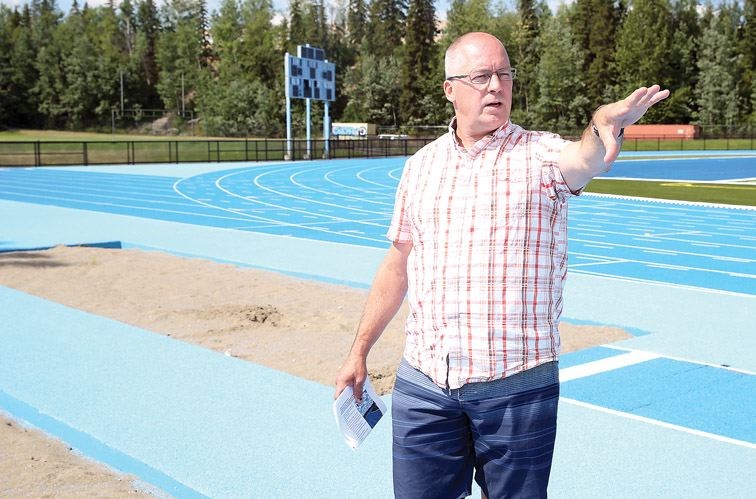A revamped Masich Place Stadium will be ready to welcome runners and walkers starting Tuesday and patrons will notice plenty of changes as they make their way around the track.
The most obvious will be the hues of bright blue and green bedecking the new surfaces and repainted stadium but the new features go well beyond the cosmetic.
City parks supervisor Chris Bjorn give local media a tour of the facility on Friday, pointing out more than a handful of the "Martha Stewart touches" that came with the $4.8-million upgrade.
Perhaps the most significant change is the installation of a new synthetic field, which meets the sizes and is marked for both Canadian and American football as well as soccer. It's similar to the turf at the Charles Jago Northern Sport Centre at UNBC but more weather resistant.
And while it will stand up bette than the old grass surface to the turns and bursts of the players and their cleated shoes, it will still need almost as much care and attention, Bjorn stressed, to the tune of seven hours per week.
Three of those hours will be devoted to "grooming" the surface - essentially cleaning it free of any foreign debris.
"That's what does the damage and you'd be surprised what's on there," Bjorn said and noted the grooming machine features a magnet to pick up any of the metal that ends up on the turf.
"Bobby pins, anything like that."
Another four hours will go to "brushing" the surface which consists of fibres of artificial grass densely sprinkled with rubber pellets that act as soil. The brushing levels out rubber pellets within the fibres.
"The fibres are basically like this," Bjorn said as he pointed a pair of his fingers upwards. "And if there were no rubber in there, they would fall over so the rubber helps support the grass."
Athletes on the field side of the track and field meets will also see some changes. For one, the throwing area has been moved out of the infield and off to the southeast side, where competitors will project their javelins, shotputs, hammers and discusses southwards and onto the grass field shared with Prince George Secondary School.
On Friday, workers were in the throwing area where they were laying down sod in the landing zone. "There was a bit of a swale here," Bjorn said. "For younger athletes that are doing shotput, discus and hammerthrow, if they were in an actual event you can't measure it properly with the dip there so they're leveling it off."
The jumping area remains in place along the east side of the track but there are now landing pits at both the north and south ends so long jumpers and triple jumpers will no longer have to run into the wind if it chooses to head in the wrong direction. The pits will also be covered when not in use.
Following a public uproar over an original plan to limit access to seven hours per day, the hours of general public use will stand at an expanded 6 a.m. to 9 p.m. unless the facility has been booked by a user group.
And when an event is being hosted, the entrance for the fans will be on the east side at the Massey Drive parking lot. A walkway bordered by chain link fencing coated with a black rubberized material will guide them to the stands on the west side.
The corridor also doubles as a viewing area for spectators taking in the throwing and jumping events. And it will take them by a sloped natural feature on the south side for fans who prefer to sit in the grass when taking in a game or track meet.
The stands have been repainted in a bright green trimmed with flat black. And once the seating area has been given a new coat of white, new moulded plastic seats will be installed.
The area behind the stands has been repaved so water no longer drains into the dressing rooms, which have also been repainted. And three rows of barbed wire top the fence along the back to keep out troublemakers late at night. The chain link is also tighter to make it tougher to climb.
For the entire time Masich is open, staff will be on site and the washrooms will reman unlocked. However, the general public will be limited to the track only.
"At this point in time the field will be closed, the stadium itself - the bleachers - will be closed as well," Bjorn said.
"Then part of what we'll be doing during walking hours will be taking surveys, chatting to people on the walking tracks. There may be groups here doing workouts, we'll be talking to them to see what kinds of things they'd love to see here in the future."
Alternating lane use will also be in force.
"It won't be all eight lanes open all the time," Bjorn said. "It will be rotating so that it's not the same two inside lanes all the time because it'll wear the track out."
And when the surface gets too hot, the stadium will be closed down completely. The cutoff will be 50 C and during the recent heat wave, the surface got as warm as 70 C.
"Of course, the middle of the day is the worst but things cool down quickly here so we're lucky for that," Bjorn added.



